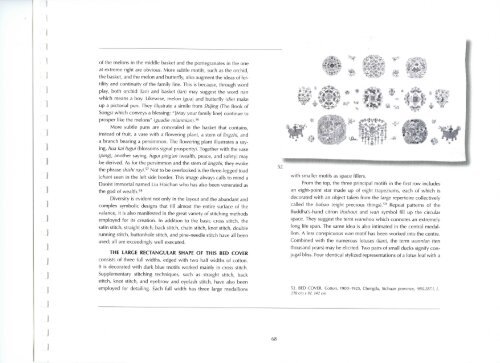Touched by Indigo - Royal Ontario Museum
Touched by Indigo - Royal Ontario Museum
Touched by Indigo - Royal Ontario Museum
Create successful ePaper yourself
Turn your PDF publications into a flip-book with our unique Google optimized e-Paper software.
of the melons in the middle basket and the pomegranates in the one<br />
at extreme right are obvious. More subtle motifs, such as the orchid,<br />
the basket, and the melon and butterfly, also augment the ideas of fertility<br />
and continuity of the family line. This is because, through word<br />
play, both orchid (/an) and basket (Ian) may suggest the word nan<br />
which means a boy. Likewise, melon (gua) and butterfly (die) make<br />
up a pictorial pun. They illustrate a simile from Shi/ing (The Book of<br />
Songs) which conveys a blessing: "[May your family line] continue to<br />
prosper like the melons" (guadie m/anm/'an).56<br />
More subtle puns are concealed in the basket that contains,<br />
instead of fruit, a vase with a flowering plant, a stem of lingzhi, and<br />
a branch bearing a persimmon. The flowering plant illustrates a saying,<br />
hua kai fugui (blossoms signal prosperity). Together with the vase<br />
(ping), another saying, fugui ping'an (wealth, peace, and safety) may<br />
be derived. As for the persimmon and the stem of lingzhi, they evoke<br />
the phrase shishi ruyi.S7 Not to be overlooked is the three-legged toad<br />
(chan) seen in the left side border. This image always calls to mind a<br />
Daoist immortal named Liu Haichan who has also been venerated as<br />
the god of wealth.58<br />
Diversity is evident not only in the layout and the abundant and<br />
complex symbolic designs that fill almost the entire surface of the<br />
valance, it is also manifested in the great variety of stitching methods<br />
employed for its creation. In addition to the basic cross stitch, the<br />
satin stitch, straight stitch, back stitch, chain stitch, knot stitch, double<br />
running stitch, buttonhole stitch, and pine-needle stitch have all been<br />
used; all are exceedingly well executed.<br />
THE LARGE RECTANGULAR SHAPE OF THIS BED COVER<br />
consists of three full widths, edged with two half widths of cotton.<br />
It is decorated with dark blue motifs worked mainly in cross stitch.<br />
Supplementary stitching techniques, such as straight stitch, back<br />
stitch, knot stitch, and eyebrow and eyelash stitch, have also been<br />
employed for detailing. Each full width has three large medallions<br />
with smaller motifs as space fillers.<br />
From the top, the three principal motifs in the first row includes<br />
an eight-point star made up of eight trapeziums, each of which is<br />
decorated with an object taken from the large repertoire collectively<br />
called the babao (eight precious things).59 Repeat patterns of the<br />
Buddha's-hand citron (foshou) and wan symbol fill up the circular<br />
space. They suggest the term wanshou which connotes an extremely<br />
long life span. The same idea is also intimated in the central medallion.<br />
A less conspicuous wan motif has been worked into the centre.<br />
Combined with the numerous lotuses (Han), the term wannian (ten<br />
thousand years) may be elicited. Two pairs of small ducks signify conjugal<br />
bliss. Four identical stylized representations of a lotus leaf with a<br />
52. BED COVER, Cotton, 1900-1925, Chengdu, Sichuan province, 980.287.1, L<br />
210cmxW. 142cm<br />
68
















